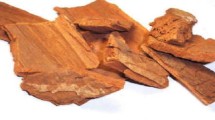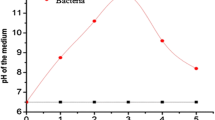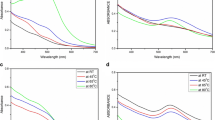Abstract
This study reports the use of aqueous mango stem bark extract (MSBE) as a source of a relatively cheap and easily accessible reducing and stabilizing agent for the biosynthesis of silver nanoparticles (AgNPs). The biosynthesis was conducted at 80 °C and pH 9 within 30 min. The FTIR and UV–Vis spectroscopic characterization of the MSBE provided evidence of chromophoric phytoconstituents with reducing functional groups. These constituents served as reducing and stabilizing agents as they were observed in the FTIR spectrum of the AgNPs. Similarly, the SEM micrograph and TGA thermogram indicated the presence of MSBE phytoconstituents on the surface of the synthesized AgNPs. The HRTEM revealed the polycrystalline nature of the AgNPs which adopted quasi-spherical and elliptical morphologies with sizes in the range 5–50 nm. The AgNPs showed remarkable catalytic activity in the degradation of methylene blue dye with a pseudo-first-order rate constant of 0.0089 s−1. The degradation was completed within 280 s. In addition, the AgNPs displayed improved antibacterial activity in comparison with the MSBE against clinical pathogens. Based on the findings in this study, AgNPs can serve as a potential catalyst in water treatment and also as an antimicrobial agent in disinfectant formulations.






Similar content being viewed by others
References
Abubakar E-MM (2009) Antibacterial efficacy of stem bark extracts of Mangifera indica against some bacteria associated with respiratory tract infections. Sci Res Essays 4:1031–1037
Al-Zaban MI, Mahmoud MA, AlHarbi MA (2021) Catalytic degradation of methylene blue using silver nanoparticles synthesized by honey. Saudi J Biol Sci 28:2007–2013. https://doi.org/10.1016/j.sjbs.2021.01.003
Ameen F et al (2019) Phytosynthesis of silver nanoparticles using Mangifera indica flower extract as bioreductant and their broad-spectrum antibacterial activity. Bioorg Chem 88:102970. https://doi.org/10.1016/j.bioorg.2019.102970
Anoop NV, Jacob R, Paulson JM, Dineshkumar B, Narayana CR (2018) Mango leaf extract synthesized silver nanorods exert anticancer activity on breast cancer and colorectal carcinoma cells. J Drug Deliv Sci Technol 44:8–12. https://doi.org/10.1016/j.jddst.2017.11.023
Atta AM, Moustafa YM, Al-Lohedan HA, Ezzat AO, Hashem AI (2020) Methylene blue catalytic degradation using silver and magnetite nanoparticles functionalized with a poly (ionic liquid) based on quaternized dialkylethanolamine with 2-acrylamido-2- methylpropane sulfonate-co-vinylpyrrolidone. ACS Omega 5:2829–2842. https://doi.org/10.1021/acsomega.9b03610
Begum R, Najeeb J, Sattar A, Naseem K, Irfan A, Al-Sehemi AG, Farooqi ZH (2020) Chemical reduction of methylene blue in the presence of nanocatalysts: a critical review. Rev Chem Eng 36:749–770. https://doi.org/10.1515/revce-2018-0047
Bharathi D, Diviya Josebin M, Vasantharaj S, Bhuvaneshwari V (2018) Biosynthesis of silver nanoparticles using stem bark extracts of diospyros montana and their antioxidant and antibacterial activities. J Nanostructure Chem 8:83–92. https://doi.org/10.1007/s40097-018-0256-7
Cheng J, Lin X, Wu X, Liu Q, Wan S, Zhang Y (2021) Preparation of a multifunctional silver nanoparticles polylactic acid food packaging film using mango peel extract. Int J Biol Macromol 188:678–688. https://doi.org/10.1016/j.ijbiomac.2021.07.161
Chieli E, Romiti N, Rodeiro I, Garrido G (2009) In vitro effects of Mangifera indica and polyphenols derived on ABCB1/P-glycoprotein activity. Food Chem Toxicol 47:2703–2710. https://doi.org/10.1016/j.fct.2009.07.017
Donga S, Chanda S (2021) Facile green synthesis of silver nanoparticles using Mangifera indica seed aqueous extract and its antimicrobial, antioxidant and cytotoxic potential (3-in-1 system). Artif Cells Nanomed Biotechnol 49:292–302. https://doi.org/10.1080/21691401.2021.1899193
Ganapuram BR, Alle M, Dadigala R, Dasari A, Maragoni V, Guttena V (2015) Catalytic reduction of methylene blue and Congo red dyes using green synthesized gold nanoparticles capped by salmalia malabarica gum. Int Nano Lett 5:215–222. https://doi.org/10.1007/s40089-015-0158-3
Garrido G et al (2009) In vivo acute toxicological studies of an antioxidant extract from Mangifera indica L. (Vimang). Drug Chem Toxicol 32:53–58. https://doi.org/10.1080/01480540802432551
Guo H, Zhang Z, Xing B, Mukherjee A, Musante C, White JC, He L (2015) Analysis of silver nanoparticles in antimicrobial products using surface-enhanced raman spectroscopy (SERS). Environ Sci Technol 49:4317–4324. https://doi.org/10.1021/acs.est.5b00370
Hamedi S, Shojaosadati SA, Mohammadi A (2017) Evaluation of the catalytic, antibacterial and anti-biofilm activities of the Convolvulus arvensis extract functionalized silver nanoparticles. J Photochem Photobiol B Biol 167:36–44. https://doi.org/10.1016/j.jphotobiol.2016.12.025
Khodadadi B, Bordbar M, Nasrollahzadeh M (2017) Achillea millefolium L. extract mediated green synthesis of waste peach kernel shell supported silver nanoparticles: application of the nanoparticles for catalytic reduction of a variety of dyes in water. J Colloid Interface Sci 493:85–93. https://doi.org/10.1016/j.jcis.2017.01.012
Kumar JS, Jana M, Khanra P, Samanta P, Koo H, Murmu NC, Kuila T (2016) One pot synthesis of Cu2O/RGO composite using mango bark extract and exploration of its electrochemical properties. Electrochim Acta 193:104–115. https://doi.org/10.1016/j.electacta.2016.02.069
Masibo M, He Q (2009) Mango bioactive compounds and related nutraceutical properties—a review. Food Rev Int 25:346–370. https://doi.org/10.1080/87559120903153524
Núñez Sellés AJ, Vélez Castro HT, Agüero-Agüero J, González-González J, Naddeo F, De Simone F, Rastrelli L (2002) Isolation and quantitative analysis of phenolic antioxidants, free sugars, and polyols from mango (Mangifera indica L.) stem bark aqueous decoction used in Cuba as a nutritional supplement. J Agric Food Chem 50:762–766. https://doi.org/10.1021/jf011064b
Núñez-Sellés AJ, Delgado-Hernández R, Garrido-Garrido G, García-Rivera D, Guevara-García M, Pardo-Andreu GL (2007) The paradox of natural products as pharmaceuticals: experimental evidences of a mango stem bark extract. Pharmacol Res 55:351–358. https://doi.org/10.1016/j.phrs.2007.01.004
Ogundare SA, van Zyl WE (2018) Nanocrystalline cellulose as reducing-and stabilizing agent in the synthesis of silver nanoparticles: application as a surface-enhanced Raman scattering (SERS) substrate. Surf Interfaces 13:1–10. https://doi.org/10.1016/j.surfin.2018.06.00
Ogundare SA et al (2021) Nanocrystalline cellulose derived from melon seed shell (Citrullus colocynthis L.) for reduction and stabilization of silver nanoparticles: synthesis and catalytic activity. Carbohydr Polym Technol Appl 2:100134. https://doi.org/10.1016/j.carpta.2021.100134
Olasehinde G et al (2018) Phytochemical and antimicrobial properties of Mangifera indica leaf extracts covenant. J Phys Life Sci (CJPL) 6:55–63
Reddeman RA et al (2019) A toxicological evaluation of mango leaf extract (Mangifera indica) containing 60% mangiferin. J Toxicol. https://doi.org/10.1155/2019/4763015
Rodeiro I et al (2006) Evaluation of the genotoxic potential of Mangifera indica L. extract (Vimang), a new natural product with antioxidant activity. Food Chem Toxicol 44:1707–1713. https://doi.org/10.1016/j.fct.2006.05.009
Rodeiro I, Delgado R, Garrido G (2014) Effects of a Mangifera indica L. stem bark extract and mangiferin on radiation-induced DNA damage in human lymphocytes and lymphoblastoid cells. Cell Prolif 47:48–55. https://doi.org/10.1111/cpr.12078
Saha J, Begum A, Mukherjee A, Kumar S (2017) A novel green synthesis of silver nanoparticles and their catalytic action in reduction of methylene blue dye. Sustain Environ Res 27:245–250. https://doi.org/10.1016/j.serj.2017.04.003
Samari F, Salehipoor H, Eftekhar E, Yousefinejad S (2018) Low-temperature biosynthesis of silver nanoparticles using mango leaf extract: catalytic effect, antioxidant properties, anticancer activity and application for colorimetric sensing. New J Chem 42:15905–15916. https://doi.org/10.1039/c8nj03156h
Sellés AJN, Agüero JA, Paz LN (2021) GC-MS analysis of mango stem bark extracts (Mangifera indica L.), Haden variety. Possible contribution of volatile compounds to its health effects. Open Chem 19:27–38. https://doi.org/10.1515/chem-2021-0192
Sengan M, Veeramuthu D, Veerappan A (2018) Photosynthesis of silver nanoparticles using Durio zibethinus aqueous extract and its application in catalytic reduction of nitroaromatics, degradation of hazardous dyes and selective colorimetric sensing of mercury ions. Mater Res Bull 100:386–393. https://doi.org/10.1016/j.materresbull.2017.12.038
Singh R, Singh S, Maharia R, Garg A (2015) Identification of new phytoconstituents and antimicrobial activity in stem bark of Mangifera indica (L.). J Pharm Biomed Anal 105:150–155. https://doi.org/10.1016/j.jpba.2014.12.010
Sorbiun M, Shayegan Mehr E, Ramazani A, Mashhadi Malekzadeh A (2018) Biosynthesis of metallic nanoparticles using plant extracts and evaluation of their antibacterial properties. Nanochem Res 3:1–16. https://doi.org/10.22036/ncr.2018.01.001
Sowmyya T (2018) Spectroscopic investigation on catalytic and bactericidal properties of biogenic silver nanoparticles synthesized using Soymida febrifuga aqueous stem bark extract. J Environ Chem Eng 6:3590–3601. https://doi.org/10.1016/j.jece.2017.01.045
Sreekanth T, Jung M-J, Eom I-Y (2016) Green synthesis of silver nanoparticles, decorated on graphene oxide nanosheets and their catalytic activity. Appl Surf Sci 361:102–106. https://doi.org/10.1016/j.apsusc.2015.11.146
Telang M, Dhulap S, Mandhare A, Hirwani R (2013) Therapeutic and cosmetic applications of mangiferin: a patent review. Expert Opin Ther Pat 23:1561–1580. https://doi.org/10.1517/13543776.2013.836182
Tolosa L, Rodeiro I, Donato MT, Herrera JA, Delgado R, Castell JV, Gómez-Lechón MJ (2013) Multiparametric evaluation of the cytoprotective effect of the Mangifera indica L. stem bark extract and mangiferin in HepG2 cells. J Pharm Pharmacol 65:1073–1082. https://doi.org/10.1111/jphp.12071
Tulve NS et al (2015) Characterization of silver nanoparticles in selected consumer products and its relevance for predicting children’s potential exposures. Int J Hyg Environ Health 218:345–357. https://doi.org/10.1016/j.ijheh.2015.02.002
Veisi H, Azizi S, Mohammadi P (2018) Green synthesis of the silver nanoparticles mediated by thymbra spicata extract and its application as a heterogeneous and recyclable nanocatalyst for catalytic reduction of a variety of dyes in water. J Clean Product 170:1536–1543. https://doi.org/10.1016/j.jclepro.2017.09.265
Vidhu V, Philip D (2014) Catalytic degradation of organic dyes using biosynthesized silver nanoparticles. Micron 56:54–62. https://doi.org/10.1016/j.micron.2013.10.006
Vimalraj S, Ashokkumar T, Saravanan S (2018) Biogenic gold nanoparticles synthesis mediated by Mangifera indica seed aqueous extracts exhibits antibacterial, anticancer and anti-angiogenic properties. Biomed Pharmacother 105:440–448. https://doi.org/10.1016/j.biopha.2018.05.151
Xiong R, Lu C, Zhang W, Zhou Z, Zhang X (2013) Facile synthesis of tunable silver nanostructures for antibacterial application using cellulose nanocrystals. Carbohydr Polym 95:214–219. https://doi.org/10.1016/j.carbpol.2013.02.077
Xu S, Zhu Q, Xu S, Yuan M, Lin X, Lin W, Qin Y, Li Y (2021) The phase behavior of n-ethylpyridinium tetrafluoroborate and sodium-based salts ATPS and its application in 2-chlorophenol extraction. Chin J Chem Eng 33:76–82. https://doi.org/10.1016/j.cjche.2020.07.024
Yang N, Li W-H (2013) Mango peel extract mediated novel route for synthesis of silver nanoparticles and antibacterial application of silver nanoparticles loaded onto non-woven fabrics. Ind Crops Prod 48:81–88. https://doi.org/10.1016/j.indcrop.2013.04.001
Yang N, WeiHong L, Hao L (2014) Biosynthesis of Au nanoparticles using agricultural waste mango peel extract and its in vitro cytotoxic effect on two normal cells. Mater Lett 134:67–70. https://doi.org/10.1016/j.matlet.2014.07.025
Zhu Q, Xu S, Wu W, Qi Y, Lin Z, Li Y, Qin Y (2022) Hierarchical hollow zinc oxide nanocomposites derived from morphology-tunable coordination polymers for enhanced solar hydrogen production. Angew Chem Int Ed. https://doi.org/10.1002/anie.202205312
Acknowledgements
WEVZ gratefully acknowledges research supported in part by the National Research Foundation of South Africa (Grant Number: 132014) and the Eskom TESP program. SAO and TOA acknowledge the support granted by Bamigbade Gafar, Akinbode Funmilayo, Ogunjobi Adebanj, and Adedeji Oluwakemi.
Author information
Authors and Affiliations
Corresponding author
Ethics declarations
Conflict of interest
The authors declare no conflict of interest.
Additional information
Publisher's Note
Springer Nature remains neutral with regard to jurisdictional claims in published maps and institutional affiliations.
Rights and permissions
Springer Nature or its licensor (e.g. a society or other partner) holds exclusive rights to this article under a publishing agreement with the author(s) or other rightsholder(s); author self-archiving of the accepted manuscript version of this article is solely governed by the terms of such publishing agreement and applicable law.
About this article
Cite this article
Ogundare, S.A., Muungani, G., Amaku, J.F. et al. Mangifera indica L. stem bark used in the bioinspired formation of silver nanoparticles: catalytic and antibacterial applications. Chem. Pap. 77, 2647–2656 (2023). https://doi.org/10.1007/s11696-022-02654-7
Received:
Accepted:
Published:
Issue Date:
DOI: https://doi.org/10.1007/s11696-022-02654-7




